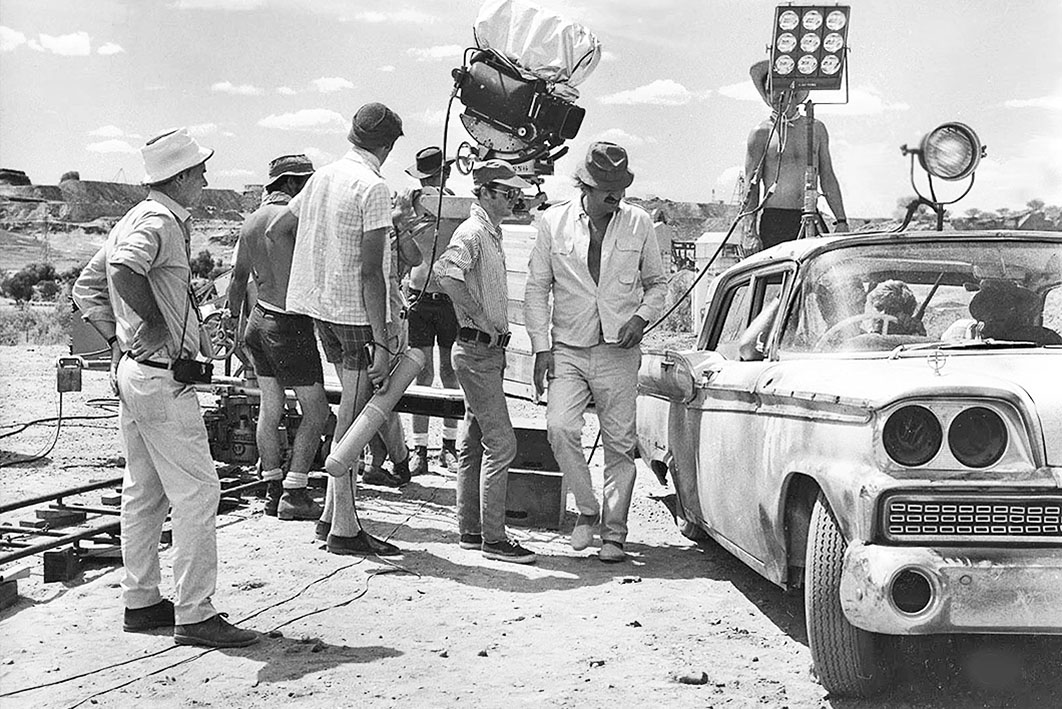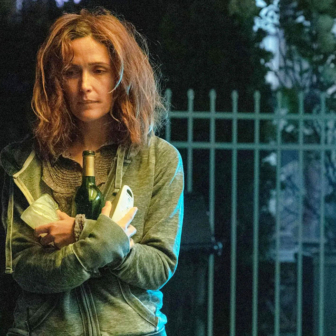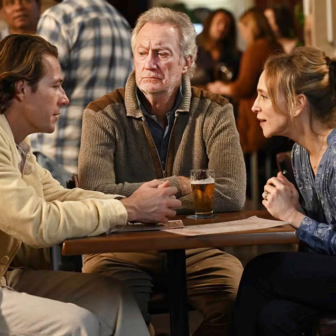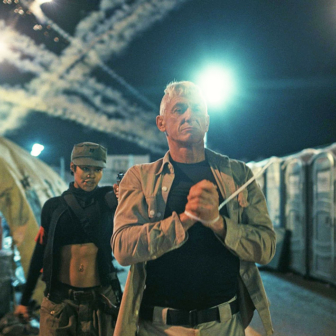Peter Browne writes: When I first met Tina Kaufman in the early 1990s I wasn’t aware of the significant role she’d played in the Sydney film scene over the preceding decade and a half, especially as editor of the monthly newspaper Filmnews. I was editing Australian Society magazine and our film reviewer, Sylvia Lawson, had recommended Tina as a potential contributor. I checked out her writing — lively, well-informed, quizzical — and asked if she’d be interested. She took on the job of previewing SBS films and series each month, and did it extremely well.
Tina went on editing Filmnews until late 1994 and then began writing for Metro, ScreenHub and other film publications (and on one occasion for Inside Story). She was a board member of the Sydney Film Festival for twenty-five years and a founding member of the Film Critics Circle of Australia, and became an honorary life member of both. Her book about Wake in Fright was published in the Australian Screen Classics series by Currency Press in 2010.
“She continuously had her finger on the pulse of the filmmaking community,” writes film historian Graham Shirley, “paying particular attention to the news, events, challenges and achievements of experimental, alternative, documentary, non-mainstream, short-subject as well as feature-length filmmakers. Tina had a clear understanding of the ‘industrial’ as well as political context in which all of them operated and was a familiar face at film community meetings and screenings of all kinds.”
We were saddened to learn of Tina’s death in Sydney last month. As some small recognition of her contribution to Australian film culture over many years, we republish her vivid account of the state of the film industry as director Ted Kotcheff was preparing to make Wake in Fright.
The late 1960s and early 1970s were the years of what came to be called the “rebirth” of the Australian film industry, although at the time nobody could have imagined how much that industry would grow over the next forty years and what films would come to be made. It’s fascinating that in 1971 both Wake in Fright and Walkabout screened at the Cannes Film Festival: two films in Australia made by outsiders — a Canadian and a Brit — that have come to be seen as enormously important in that rebirthing process.
Both films are unlike anything that had previously been made in Australia, but of the two, Wake in Fright is perhaps the stronger, more savage and harder-hitting film. The more I discover about it, the more intrigued I am by how such a film got made, at that time and in such an unlikely fashion.
In his book about Nicolas Roeg’s film Walkabout, Louis Nowra talks about the barren cultural landscape out of which the two films emerged. But even if it appeared barren, there must have been something there to provide the fertility for such an energetic, striving plant to germinate and eventually to thrive. Was that barrenness an illusion? Were there little patches of vegetation and, underneath, many young shoots getting ready to sprout? Was there dormant and emerging filmmaking life in what would appear to future commentators as a wasteland?
Australia had been making films (it could only occasionally have been called an industry) since almost the beginning of cinema in the 1890s, but it had always been a very stop-start affair. In the heyday of production in the 1920s and 1930s, between ten and fifteen features were made a year, but in the years leading up to 1970 production had slowed to something less than a trickle, more an occasional splutter.
Of course, there were the overseas productions. In fact, 1959 saw a veritable flurry of activity, with Stanley Kramer making On the Beach in Melbourne, Harry Watt directing The Siege of Pinchgut in Sydney, and Leslie Norman making Summer of the Seventeenth Doll, also in Sydney. And in 1960 Fred Zinnemann made The Sundowners with Deborah Kerr and Robert Mitchum. But not one of these directors was Australian; indeed, as critic and former Sydney Film Festival director David Stratton says in his afterword to the new edition of Kenneth Cook’s novel Wake in Fright:
The high-profile “Australian” films made during this period weren’t Australian productions at all. Most of them, including The Overlanders, Eureka Stockade, Bush Christmas, The Shiralee, Smiley, The Siege of Pinchgut and the 1957 version of Robbery under Arms, were British films, often shot in studios in the UK with Australia used only for the location work; others, including Kangaroo, On the Beach and The Sundowners, were mainstream Hollywood productions made on location here.
And, as Stratton also comments in his book The Last New Wave, “Australian stories were being filtered through foreign eyes, and a strange variety of foreign actors were pretending to be Australians.”
But if very few Australian features were being made, by the mid 1960s an active production sector was making newsreels, television programs and television commercials, while government-funded films were being produced at the Commonwealth Film Unit. Newer, lighter cameras helped the filmmakers who were making surfing, travel and adventure documentaries to go up the coast and into the bush and the outback in search of stories. There were six small studios with sound stages in Sydney, another in Melbourne, and about a dozen laboratories to do the processing and post-production.
In Australian Cinema: The First Eighty Years, film historians Graham Shirley and Brian Adams refer to “more than fifty film production companies employing from five to over a hundred people each” and comment that “among these various film production bodies, along with the television studios, underground filmmakers, filmmakers returning from abroad, and individual film critics, the desire for a reborn film industry grew.”
In fact, as legendary filmmaker Ken G. Hall wrote in 1967 in the short-lived theatre and film journal Masque:
There is an Australian film industry at this moment and it is keeping more people in regular employment than ever before. There are available to prospective producers ten times the facilities — studio space, modern equipment — than was available to, say, Charles Chauvel and myself in the 30s and 40s. The days of one camera and, at best, two microphones, together with some equipment made out of Meccano parts and literally tied up with wire, are no more. Much more footage is being shot than in that production heyday and there are more laboratories, including many excellent colour laboratories, than were ever dreamed of then. The trouble is that these people, this studio space and facilities, are not being used to make what most interested people would want them to be used for — feature film production.
Of course, this supposes that the production of feature films is the ultimate goal of any film industry, an issue raised by Susan Dermody and Elizabeth Jacka in The Screening of Australia (Vol. 1). “Why is feature film production assumed to be the real point of an industry?” they ask, and continue:
The assumption goes back to the phase of film history, from the silent period to the peak audiences of 1946, when movies were the dominant popular art, when people “went,” on average, two to three times a week, when the industry was the third or fourth biggest revenue-earner in the United States, and there was no television. That’s part of the answer. Another part is that the marketing of films (to paying audiences, rather than to client groups, as is the case with educational films or broadcasting interests) is organised around the event of the feature, which must be large, emphatic and powerful enough to warrant travel, ticket-price and several hours of voluntary attendance in the dark.
While it is the feature film that attracts that paying audience, its production is also what many filmmakers see as their ultimate goal, and even in these bleak years some determined filmmakers did manage to make features.
One was Tim Burstall, who in 1969 made 2000 Weeks, a semi-autobiographical tale about the frustration and isolation of an artist in the Australian wasteland. Actor and writer Graeme Blundell, who was in the film, writes about the experience in his very entertaining memoir of those early years, The Naked Truth: A Life in Parts, describing it as “a subjective view of a writer’s crisis when he calculates he only has 2000 weeks in which to express himself.” It was, as David Stratton (who programmed it in that year’s Sydney Film Festival) says in The Last New Wave, “a remarkably ambitious film.”
Tim Burstall had made a short children’s film, The Prize, which won an award at the Venice Film Festival in 1960. He’d then made some documentaries and a children’s TV series, had been working in the US film industry for two years on a Harkness Fellowship, and thought he was ready for his first feature. Released in Melbourne in March 1969 with high (probably too high) expectations, it was reviewed badly and taken off after eleven days, while the Sydney Film Festival screening some months later was a disaster. “Burstall was devastated,” reported Graeme Blundell, “and developed a deep hatred for what he called ‘the intelligentsia.’ They were ‘highbrows and ABC types’ and they seemed affronted by the simple decency of the film.”
In 1971 Burstall made Stork and he had to pay for the first screening in Melbourne. It did so well that it got picked up by mainstream distributors Roadshow, not only becoming the new Australian cinema’s first box office success but also reinvigorating Burstall’s career and scooping the pool at the 1973 AFI Awards, the year he made the highly successful Alvin Purple. In that film Blundell let everything hang out, shocking some of the more straitlaced critics but nevertheless delighting the cinema-going public and delivering a very large profit. But Burstall never forgot or forgave the treatment given to 2000 Weeks.
Behind the scenes, many of those working in film and television had been lobbying the government for years for some form of government support for production; broadcaster Phillip Adams, then both a successful advertising man and prospective filmmaker, and his friend, historian and Labor Party stalwart Barry Jones (who had been unofficially advising then Liberal prime minister John Gorton on cultural issues) proposed to Gorton the setting up of a national film school. In 1969 a screening for federal parliamentarians of Anthony (Tony) Buckley’s documentary Forgotten Cinema, an account of the rise and fall of the Australian feature film pioneers, was given some credit for persuading Gorton to finally give some assistance to the industry.
In 1969 the Commonwealth government announced a three-part program of assistance: an investment corporation to support feature films and television programs, a national film school, and an experimental film fund to assist in the making of low-budget films and encourage emerging filmmakers. While the film school didn’t come into being until 1973, the Australian Film Development Corporation was set up in 1970, as was the Experimental Film and TV Fund, initially administered by the Australian Film Institute.
For many of those who have since written about the period prior to government support, it may have seemed a very insular, bleak and unrewarding time. For those who were there, however, it was different: their memories reveal a screen culture buzzing with activity and ideas, infused by commercial enterprise, by television and commercials, and energised by popular, classic and foreign films. Nor was it a one-way street: just as the Australian industry was open to ideas from overseas, Australian ideas, energies and talent also flowed abroad.
Take producer Richard Brennan, for example. As he wrote in early 2009 just after his retirement as a project officer for the federal government funding body Screen Australia, he has been in love with cinema since he was ten: “I have read about films, watched them, and studied them. And since I was seventeen I have worked on them.” That all started when he met Bruce Beresford at Sydney University in 1960, “both dreaming of being filmmakers,” and they made a short film called The Devil to Pay. Richard then made several other short films and, upon graduating, went on to work first as a production assistant at the ABC, and then at the Commonwealth Film Unit (later Film Australia). In 1970 he produced and directed a documentary in support of the May moratorium which launched the anti–Vietnam war movement in Australia, Or Forever Hold Your Peace, which was the first film financed by the newly created Experimental Film and TV Fund. He then produced Peter Weir’s short drama Homesdale, which won the rarely given Grand Prix at the Australian Film Institute Awards.
So, for Richard and others like him, it was a time of terrific optimism. He recalls vividly how cinema opened up the rest of the world for him, telling me:
We’d just seen two locally made features in release, The Naked Bunyip and Nickel Queen, and at Film Australia we were working on two more, Brian Hannant’s Flashpoint and Cecil Holmes’s Gentle Strangers. We actually saw a future in filmmaking. And we were inspired by the films we were seeing; that year, at the Sydney Film Festival, I’d seen Truffaut’s Bed and Board, Peter Watkins’s Punishment Park, Pasolini’s Teorema, Bunuel’s Tristana, Eric Rohmer’s Claire’s Knee, and Bernardo Bertolucci’s The Conformist.
Richard’s immaculately kept diaries, which have become a great source of information for friends whose memories or record-keeping aren’t nearly as reliable, record that he thought Wake in Fright “outstanding” and Donald Pleasence’s performance very impressive, and he noted “what a star Jack Thompson is going to be.” They also record what novelist Frank Moorhouse told him on 3 November 1971 — that Wake in Fright “gave him a thirst, an interest in homosexuality and an itchy ‘trigger finger.’”
The next month Richard was off to London to work as production manager on The Adventures of Barry McKenzie, written by Barry Humphries and directed by his old friend Bruce Beresford. Thirty or so films later, some as production manager, many more as producer (and occasionally as actor), Richard remembers this as “one of the highlights of my life; it was my first feature and my first time overseas.”
Howard Rubie, who would be the first assistant director on Wake in Fright, is another who remembers the early years of the Australian film renaissance — and even those before, in the 1950s and 1960s — as a highly productive period. In 1954, aged sixteen, he had started at Cinesound as a camera assistant, working on newsreels, short documentaries for cinemas, corporate documentaries and, later, news footage for Channel Nine. He started about the same time as a young editing assistant, Tony Buckley, and by 1967 they were both working for Ajax Films. “We were making a lot of TV commercials, especially cigarette commercials,” Rubie told me, continuing:
There was an incredible amount of activity in the non-feature area, and commercial production was the cornerstone of that activity. Even in the mid-sixties everyone was aspiring to features. We talked about the UK productions that were being made here by Harry Watt and Ealing Studios. And we talked about Charles Chauvel’s Sons of Matthew and about Lee Robinson and Chips Rafferty’s films as showing the way. There was a feeling of disappointment that the Australian industry had declined so much, but there was always a hope that it could be revived.
Involved in that possible revival was the company that would co-produce Wake in Fright, NLT Productions, so named after its entrepreneurial partners, Jack Neary, Bobby Limb and Les Tinker.
The company had been making “family” shows for television since the early 1960s, centred around the successful weekly variety show The Bobby Limb Show, featuring Limb, who was at the time a popular personality, singer and comedian who’d made his name and reputation on radio and in the clubs. Jack Neary, his manager and agent, also owned nightclubs, while Les Tinker was a Leagues Club manager who had financed the company.
In 1968 this small Australian company got involved with the US company Group W, a division of the major US multinational Westinghouse, which at the time operated a small US television network, and signed a co-production deal to make ten features in five years. This was an incredibly ambitious undertaking even for an experienced production team. There is some uncertainty about how these two companies got into bed with each other, but Howard Rubie thinks it had something to do with the Channel Nine connection.
As explained by film historians Andrew Pike and Ross Cooper in their book Australian Film 1900–1977, “NLT was supported in the venture by Motion Picture Investments, a company directed by prominent Australian businessmen, including Sir Reginald Ansett. Investment was on a major scale and the budget for the first film was $750,000.”
That first feature, Squeeze a Flower, was a comedy about a secret recipe for a liqueur known only to an Italian monk, played by Italian actor Walter Chiari, who comes to Australia to work at a Hunter Valley vineyard. The film was made quickly, with the principal members of cast and crew imported and everyone else Australian. The director, Mark Daniels, was American. Released in February 1970, the reviews weren’t good and it flopped.
But by this time NLT was getting ready to make their second feature — Wake in Fright. •
This is an extract from Tina Kaufman’s Wake in Fright, published in the Australian Screen Classics series, edited by Jane Mills, by Currency Press and the National Film and Sound Archive.




